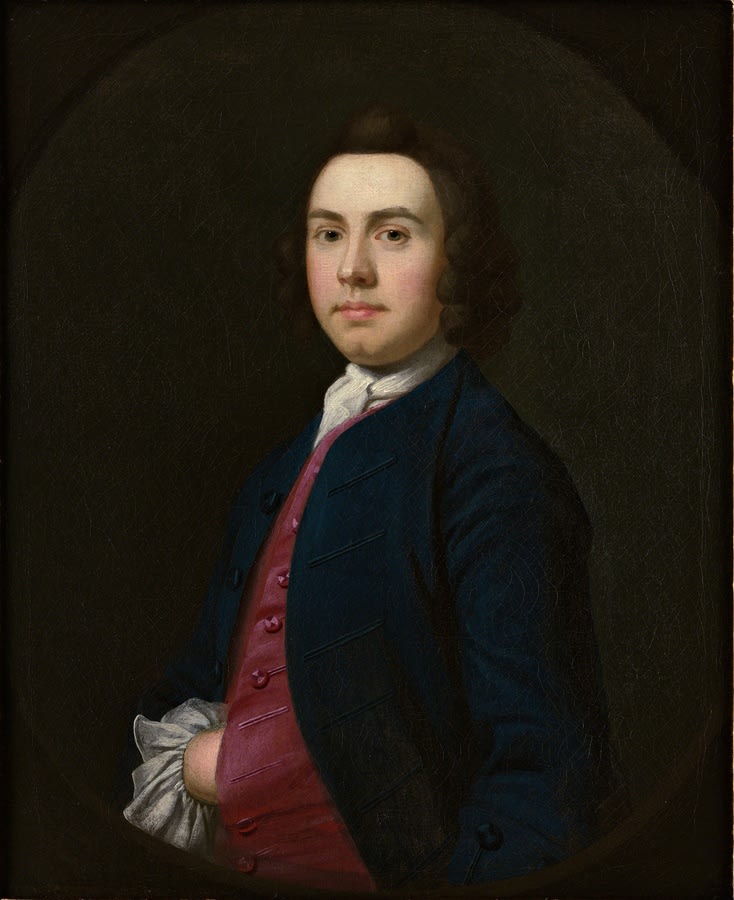
William Keable
To view all current artworks for sale visit philipmould.com
This recently discovered portrait is a rare addition to William Keable’s oeuvre, from which only a handful of works are known to survive. This canvas dates from the late 1740s, and is closely related to his 1748 Self-Portrait [Yale Center for British Art, USA] and the 1749 Mrs Benjamin Smith [Gibbes Museum of Art, USA]. Keable also painted small full-lengths, in the manner of Arthur Devis.
Keable is perhaps best known today as the central figure in one of Thomas Gainsborough’s earliest and most popular works, the c.1748 group portrait Crokatt, Keable and Muilman in a Landscape [Tate Gallery, London], in which Keable features in the centre, playing a flute. Hugh Belsey has suggested that Keable may have had a hand in the painting of his own figure. Keable was a keen amateur musician and accomplished violinist, and, through music and his probable native home of Suffolk, must have been well acquainted with Gainsborough.
By the late 1740s Keable had established himself as a portraitist in London, and by 1754 was working in the Second St Martin’s Lane Academy. He was patronised by a number of American Colonists traveling in London, particularly from Charleston, South Carolina. Two such works, the 1749 portraits of Mrs Benjamin Smith (1722-60) and her brother-in-law Thomas Smith Jr (1719-90), were exhibited in the Gibbes Museum of Art 1999 exhibition “In Pursuit of Refinement - Charlestonians Abroad 1740-1860”, and show the important transfer of artistic taste from mid-eighteenth century England to the Americas.
In 1751 Keable was the victim of disparaging remarks from another Charlestonian, Peter Manigault, who had chosen to be painted by the more expensive Allan Ramsay. Manigault wrote;
“I was advised to have it drawn by one Keble, that drew Tom Smith and several others that went over to Carolina, but upon seeing his paintings, I found that though his Likenesses (which is the easiest Part in doing a Picture) were some of them very good, yet his Paint seemed to be laid on with a Trowel, and looked more like Plaistering than Painting, you may guess at the Difference between Ramsay & Keble Painting, by the Difference of their Prices, What Ramsay demands Four & Twenty Guineas for, T’other humbly hopes you’ll allow him Seven.”
It is possible that the sitter in the present work is Benjamin Smith (1717-1770), a wealthy trader between South Carolina and England, who later became Speaker of the House of Commons in South Carolina. It seems almost certain that Benjamin Smith would have sat to Keable had his wife and brother-in-law also sat to the artist, at about the same date of the present picture. Furthermore, there is a marked similarity in likeness with a later portrait of Benjamin Smith as an older man by John Wollaston (Albrecht-Kemper Museum, Missouri).
It was perhaps through a lack of ready patronage that Keable left to settle in Italy by 1761. In 1770 he became a member of the Academia della Clementina, and a number of portraits of musicians are recorded from this time. Keable is buried in Livorno.
Provenance
Exhibitions
Literature
Be the first to hear about our available artworks
* denotes required fields
We will process the personal data you have supplied in accordance with our privacy policy (available on request). You can unsubscribe or change your preferences at any time by clicking the link in our emails.